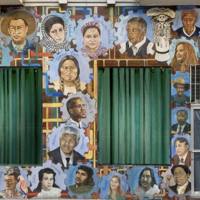
La L.ucha Continua/The Struggle Continues
This mural was painted on 3260 23rd St, between Mission and Capp Streets, in San Francisco by Susan Caruso Green, and was a community collaboration between muralists and local residents. It brings together faces from global history who have fought for civil rights, including the antislavery leader Harriet Tubman, Nelson Mandela, Gandhi, Mumia Abu-Jamal, Malcolm X, and Martin Luther King Jr.
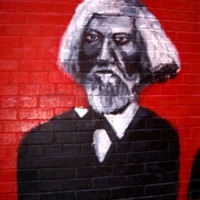
Paintin' the Town
In 1997, a muralist working for the Old Town Development Board completed a mural called Paintin’ the Town on North Loudoun Street in Winchester, Virginia. It includes a depiction of Douglass during the later period of his life. It had now been destroyed.
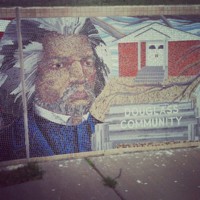
Tracks of Our Past and Future
In Plano, Texas, artists Lynne Chinn and Shug Jones created a mosaic mural titled Tracks of Our Past and Future. Made in 2006, the mural is 75 feet long and celebrates the African American community of Plano, Texas. At the centre of the mural is the antislavery leader Frederick Douglass.
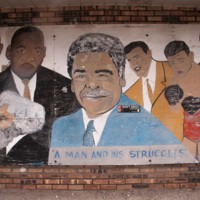
A Man and His Struggles
Titled A Man and His Struggles, this mural by Magic Fingers is in the Oak Park area of Chicago and depicts the first African American mayor of the city, Harold Washington, alongside Martin Luther King Jr., Jesse Jackson, and the antislavery leader Frederick Douglass. In 2016, artists updated the mural, to add the Pan-African flag along its bottom edge.
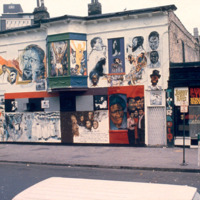
Wall of Respect
The Wall of Respect was the first exterior African American mural in the United States. Painted by OBAC (Organisation of Black American Culture), it underwent three main phases, as shown throughout the photographs here. Its creation was an inclusive process, asking local residents to decide which black heroes should be included in the mural. This was an integral step in the mural-making process because “any muralist who’s doing anything of a thoughtful nature should always have an input from the community,” artist Bill Walker observed. “You can’t do things that make people think they’re not a part of things.” Compiling a newsletter and consulting local militant street gangs, OBAC wrote a list of historic and contemporaneous figures to be memorialised on the wall, before waiting for their approval. “The militant [members of the community] were the ones that defined who would go on the wall and who would not,” artist Eugene Eda Wade remembers in a 2017 oral history interview. The choices were figures from the past and present who “charted their own course” through life and “did not compromise their humanity,” including the antislavery leader Nathaniel Turner, as well as James Brown, James Baldwin, Thelonious Monk, Malcolm X, Nina Simone, Claudia McNeil, Stokely Carmichael, H. Rap Brown, Elijah Muhammad, Gwendolyn Brooks and Muhammad Ali. By celebrating radical black heroes of the past and present, the mural became a site of black cultural heritage and an unofficial landmark on Chicago’s southside. It also catalysed a national mural movement, with more than 300 murals painted in Chicago alone over the next few decades. In 1971, the mural was destroyed in a fire.
![Leroy White, Wall of Respect, Up You Mighty Race, Leffingwell & Franklin Aves, St. Louis MO, 1968 [destroyed 1980s].jpg Leroy White, Wall of Respect, Up You Mighty Race, Leffingwell & Franklin Aves, St. Louis MO, 1968 [destroyed 1980s].jpg](https://486312.frmmmguz.asia/files/square_thumbnails/ccbe25581b885dd6ea7ad25405af90fe.jpg)
Wall of Respect/Up You Mighty Race
In 1968, after the success of Chicago’s Wall of Respect in 1967, muralist Leroy White painted Wall of Respect/Up You Mighty Race in St. Louis, Missouri. The mural was self-sponsored. After seeing Chicago’s Wall of Respect in Ebony, muralists in St. Louis were inspired to create public art in the Carr Square area of the city. The mural was completed by a coalition of individuals from civil rights groups, including CORE, ACTION, and the Zulu 1200s. It displayed a pantheon of black heroes, including the antislavery leaders Frederick Douglass, Malcolm X, Martin Luther King Jr., and Marcus Garvey. The mural quickly became a hub of black activism—bringing together artists, performers and political figures in a series of concerts and rallies at the site. But it was vandalised during the 1970s, and its building was razed in the 1980s.
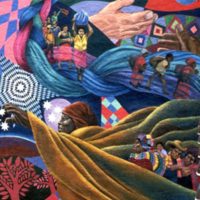
Sanctuary: the Spirit of Harriet Tubman
In 1986, muralist David Fichter created a mural on the side of the Paul Robeson Theatre in Atlanta, Georgia. The mural was sponsored by the city of Atlanta, and depicts Harriet Tubman leading slaves to freedom via the Underground Railroad, against a quilted backdrop..
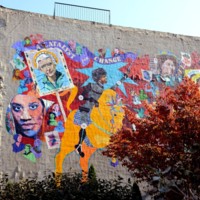
When Women Pursue Justice
In 2005, Artmakers Inc. created a large-scale political mural titled When Women Pursue Justice. During the genesis of the mural, it seemed like an overly ambitious project with little funding, and a heavy reliance on the generosity of its collaborators. Located in Brooklyn, at the busy intersection between Nostrand and Greene Avenue, the mural is populated with women who worked towards justice and social change over the last 150 years. The most visually noticeable figure on the mural is the thirty-five-foot image of Shirley Chisholm astride a golden horse and dressed in armour of African mud and kente cloth. Surrounding Chisholm are 90 women who risked their lives and liberty to achieve voting rights, civil rights, racial justice, health and reproductive rights, and environmental justice and protection – including the abolitionists Harriet Tubman and Sojourner Truth, as well as Angela Davis, Wilma Mankiller, Margaret Sanger, and Dorothy Day.
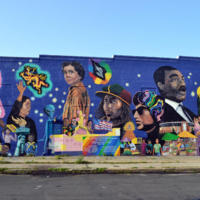
A Little Help From Our Friends
In 2008, Baltimore Green Construction and Rebuilding Together Baltimore contacted Dr. Bob Hieronimus. They asked him to participate in a renovation project throughout the city, including a complete recreation of the 1996 mural A Little Help from Our Friends. The mural is located at Johns Hopkins University’s Office of Volunteer Services and features the faces of Gandhi, Jackie Robinson, Bob Marley, Bob Dylan, Rev. Martin Luther King Jr., and the abolitionist Harriet Tubman, among others. In 1996, the mural won the best mural award from WMAR-TV and was visited by Bob Marley’s sons, Ziggy and Stephen.
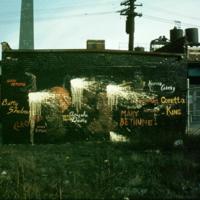
Racism
In 1970, a mural titled Racism appeared in the Cabrini-Green Housing Projects in Chicago’s southside. It celebrated black women who had been key participants in the struggle for black liberation. The mural depicted the faces of Nina Simone, Angela Davis and Kathleen Cleaver, along with the names of Aunt Jemima, Betty Shabazz, Cleopatra, Mary McLeod Bethune, Coretta Scott King and the abolitionist Sojourner Truth. The mural was defaced with white paint shortly after its completion.
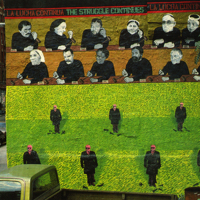
The Last Judgement
This mural, part of a wider series called La Lucha Continua/The Struggle Continues, is split into two halves. The bottom half shows anonymous arms merchants in suits, and the top portrait shows portraits of local residents alongside the leaders Nelson Mandela, Daniel Ortega, Robert F. Williams and the abolitionist Harriet Tubman, among others.
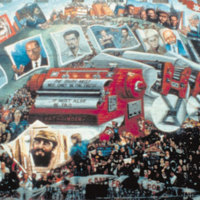
Pathfinder Mural
In 1988, Mike Alewitz designed and began to direct the creation of Pathfinder Mural in New York City’s West Village. The mural, measuring 79 x 85 feet, was an international collaboration of 80 artists from 20 different countries including Argentina, Canada, Iran, New Zealand, Nicaragua and South Africa. At its dedication, it was hailed as one of the largest political murals in the world. In 1987, Alewitz had approached the leaders of the Socialist Workers Party (SWP), of which he was a member, and proposed that Pathfinder Press sponsored a mural for its Charles Street building. The party approved both the project and his concept of the mural: a celebration of the revolutionary struggles in Cuba, Grenada, Nicaragua and South Africa, as well as in America. The central image of the mural is a large red printing press. The faces of Fidel Castro, Che Guevara, Malcolm X, Karl Marx, and Nelson Mandela loop around it. The abolitionists Frederick Douglass, Harriet Tubman and Sojourner Truth also feature. During the creation of Pathfinder Mural, the National Endowment for the Arts withdrew funding from several controversial projects, prompting a debate on free speech and censorship. For the first few months of this mural's creation, work continued without incident. But in 1989, Patrick Buchanan, a conservative commentator, vilified the mural in the Washington Times, calling it a “six-story shrine to communism, a Marxist Mount Rushmore in Greenwich Village." As the mural neared completion, the dialogue between Alewitz and the SWP started to break down. Alewitz was blocked from attending the mural dedication ceremony on November 19, 1989. During December, vandals threw glass bottles filled with white paint at the mural. In 1996, the mural was removed in order to repair cracks in exterior wall of the Pathfinder building, and by 2003, the building on which Pathfinder Mural was housed was sold for around $20 million.
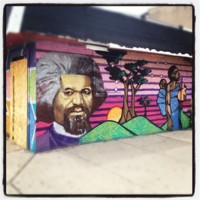
North Lawndale Mural
A teacher at North Lawndale College Preparatory Charter High School, Katie Bordner, created this mural with her students in 2012. It depicts the abolitionist Frederick Douglass, a mother and child and an African backdrop.
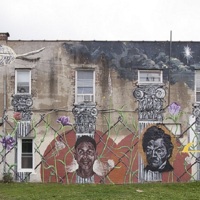
I Am, Yo Soy/Wall Therapy
As part of a Rochester WALL\THERAPY mural project in 2013, muralist Lunar New Year used Trayvon Martin, a young Frederick Douglass, and a local resident called Christopher to depict three possible paths of African American manhood in his mural I Am/Yo Soy. The young boy on the edge of the mural pleads to the North Star in the sky in a position that echoes Josiah Wedgwood’s famous 18th-century "Am I Not a Man and a Brother" medallion. An older version of Douglass then sits on the right side on the mural, as the only figure beyond the real and painted chain link fences.Lunar New Year, who is an Ecuadorian American Newark-based artist, explained that the mural is about “the history of institutionalized injustice in the USA… Injustice forged Frederick Douglass’s character, robbed Trayvon Martin of his life and [it] is up to us, to dictate what future awaits for young 7 year old Christopher from Rochester.”
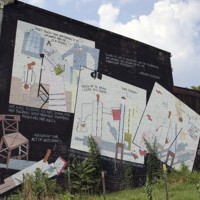
Young Frederick Douglass' Quest to Read
In 2000, muralist Gary Mullen created a mural that depicts how abolitionist Fredrick Douglass learned to read. It is located in the city of Baltimore, where the abolitionist spent the formative years of his life as a slave, and where he taught himself to read. Titled Young Frederick Douglass’ Quest to Read, the mural was created bring pride to the residents of the Latrobe Homes area of north Baltimore. After reading Narrative of the Life of Frederick Douglass, the story stayed with Mullen, and when asked by the Brentwood Village Initiative to propose a mural design, the story of Douglass’ life in Baltimore was the perfect subject. The panel scenes depict Douglass’ master, Hugh Auld, scolding his wife, Sophia, for assisting Douglass to read—an illegal act at the time; Douglass trading Sophia Auld’s bread to hungry white children in exchange for reading lessons; Douglass challenging children to write as well as he does; and 12 year-old Douglass discovering the meaning of abolition. Mullen created the mural to emphasise the importance of education to the African American community in Baltimore, and local residents have received it enthusiastically, “It’s not everyday you get a mural like this in your community,” committee organiser, Patrick Lee said.
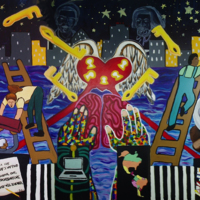
Picturing Our Dreams
Picturing Our Dreams is by incarcerated youth at the Monroe Correctional Facility in Rochester, New York. The mural was created in collaboration with a New York State Library Centre writer, visual artist and Rochester School District teachers. The ideology behind the mural was that inmates could communicate the idea that there is freedom and knowledge inside the jail system. In the centre of the mural, a heart with many key-holes floats around the corresponding keys, and above are the faces of the abolitionists Harriet Tubman and Frederick Douglass, as well as Barack Obama and Dr. Martin Luther King Jr.
![Wardell McClain, Sim's Corner Wall of Respect, 618 E 47th St at South Champlain Ave. [Black Neighborhood], Chicago, 2009.jpg Wardell McClain, Sim's Corner Wall of Respect, 618 E 47th St at South Champlain Ave. [Black Neighborhood], Chicago, 2009.jpg](https://486312.frmmmguz.asia/files/square_thumbnails/1018bd0dce61a7264d61cd9907fc7cfe.jpg)
Sim's Corner Wall of Respect
In 2009, Wardell McClain created a mural on South Champlain Avenue in Chicago, Illinois titled Sim's Corner Wall of Respect, that took its inspiration from the 1967 mural, Wall of Respect. It includes the faces of the abolitonists Frederick Douglass, Harriet Tubman, and Sojourner Truth as well as Martin Luther King Jr., Jesse Jackson, Malcolm X, Harold Washington, Elijah Muhammad, Nelson Mandela, Michael Jordan, Coretta Scott King, Marcus Garvey and Booker T. Washington.
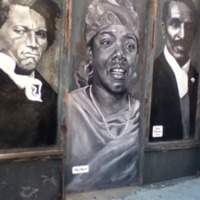
Asheville Mural
This mural was created by Harper Leich in Asheville, North Carolina in 2012 but had been destroyed by 2016. It includes the faces of Frederick Douglass, Maya Angelou, and George Washington Carver.
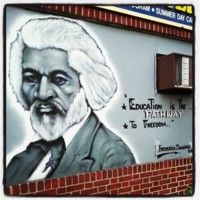
Educational Mural
This mural was painted in the Bronx, New York City by an unnamed artist and depicts Frederick Douglass in the later years of his life, and the phrase "Education is the pathway to freedom." it had been destroyed by 2016.
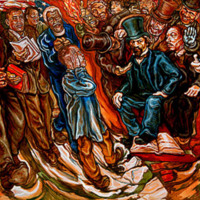
Wall of Black Heroes
In 2006, muralist Joseph Tiberino, along with his sons Gabe and Raphael, painted Wall of Black Heroes for the African American Museum of Philadelphia. When creating the mural, the idea was to provide a portable piece of work that would later be housed in the streets. Measuring 4ft by 12ft, the mural was created on such a scale so as to provide the audience with the sense that the figures of history were life-size. The mural takes the audience on a historical journey, starting with a self-emancipating shackled slave, then moving to the abolitionists Frederick Douglass andHarriet Tubman, then Angela Davis and Malcolm X, Spike Lee, Paul Robeson, Louis Armstrong and Martin Luther King Jr. The mural is now on the side of the Municipal Services Building next to City Hall.